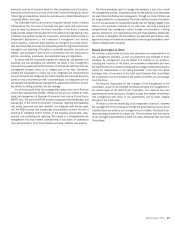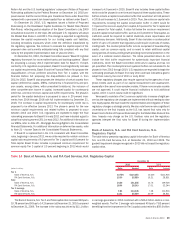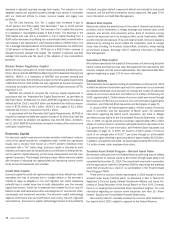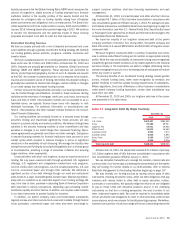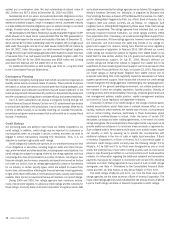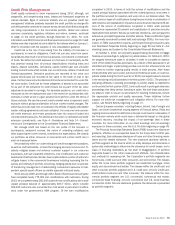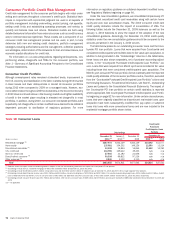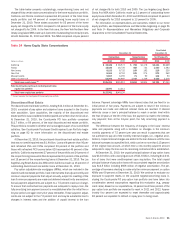Bank of America 2010 Annual Report Download - page 76
Download and view the complete annual report
Please find page 76 of the 2010 Bank of America annual report below. You can navigate through the pages in the report by either clicking on the pages listed below, or by using the keyword search tool below to find specific information within the annual report.earliest put or redemption date. We had outstanding structured notes of
$61.1 billion and $57.0 billion at December 31, 2010 and 2009.
Substantially all of our senior and subordinated debt obligations contain
no provisions that could trigger a requirement for an early repayment, require
additional collateral support, result in changes to terms, accelerate maturity
or create additional financial obligations upon an adverse change in our credit
ratings, financial ratios, earnings, cash flows or stock price.
We participated in the FDIC’s Temporary Liquidity Guarantee Program (TLGP)
which allowed us to issue senior unsecured debt that the FDIC guaranteed in
return for a fee based on the amount and maturity of the debt. At December 31,
2010, we had $27.5 billion outstanding under the program. We no longer issue
debt under this program and all of our debt issued under TLGP will mature by
June 30, 2012. Under this program, our debt received the highest long-term
ratings from the major credit ratings agencies which resulted in a lower total cost
of issuance than if we had issued non-FDIC guaranteed long-term debt. The
associated FDIC fee for the 2009 issuances was $554 million and is being
amortized into expense over the stated term of the debt.
For additional information on debt funding, see Note 13 – Long-term Debt
to the Consolidated Financial Statements.
Contingency Planning
We maintain contingency funding plans that outline our potential responses to
liquidity stress events at various levels of severity. These policies and plans
are based on stress scenarios and include potential funding strategies, and
communication and notification procedures that we would implement in the
event we experienced stressed liquidity conditions. We periodically review and
test the contingency funding plans to validate efficacy and assess readiness.
Our U.S. bank subsidiaries can access contingency funding through the
Federal Reserve Discount Window. Certain non-U.S. subsidiaries have access
to central bank facilities in the jurisdictions in which they operate. While we do
not rely on these sources in our liquidity modeling, we maintain the policies,
procedures and governance processes that would enable us to access these
sources if necessary.
Credit Ratings
Our borrowing costs and ability to raise funds are directly impacted by our
credit ratings. In addition, credit ratings may be important to customers or
counterparties when we compete in certain markets and when we seek to
engage in certain transactions including OTC derivatives. Thus, it is our
objective to maintain high-quality credit ratings.
Credit ratings and outlooks are opinions on our creditworthiness and that
of our obligations or securities, including long-term debt, short-term borrow-
ings, preferred stock and other securities, including asset securitizations. Our
credit ratings are subject to ongoing review by the ratings agencies and thus
may change from time to time based on a number of factors, including our own
financial strength, performance, prospects and operations as well as factors
not under our control, such as ratings agency-specific criteria or frameworks
for our industry or certain security types, which are subject to revision from
time to time, and conditions affecting the financial services industry generally.
In light of the recent difficulties in the financial services industry and financial
markets, there can be no assurance that we will maintain our current ratings.
During 2009 and 2010, the ratings agencies took numerous actions,
many of which were negative, to adjust our credit ratings and the outlooks for
those ratings. Currently, Bank of America Corporation’s long-term senior debt
and outlook expressed by the ratings agencies are as follows: A2 (negative) by
Moody’s Investors Services, Inc. (Moody’s), A (negative) by Standard and
Poor’s Ratings Services, a division of The McGraw-Hill Companies, Inc. (S&P),
and A+ (Rating Watch Negative) by Fitch, Inc. (Fitch). Bank of America, N.A.’s
long-term debt and outlook currently are as follows: A+ (negative), Aa3
(negative) and A+ (Rating Watch Negative) by those same three credit ratings
agencies, respectively. The ratings agencies have indicated that, as a sys-
temically important financial institution, our credit ratings currently reflect
their expectation that, if necessary, we would receive significant support from
the U.S. government. All three ratings agencies, however, have indicated they
will reevaluate, and could reduce the uplift they include in our ratings for
government support for reasons arising from financial services regulatory
reform proposals or legislation. In February 2010, S&P affirmed our current
credit ratings but revised the outlook to negative from stable based on its
belief that it is less certain whether the U.S. government would be willing to
provide extraordinary support. On July 27, 2010, Moody’s affirmed our
current ratings but revised the outlook to negative from stable due to its
expectation for lower levels of government support over time as a result of the
passage of the Financial Reform Act. Also, on October 22, 2010, Fitch placed
our credit ratings on Rating Watch Negative from stable outlook due to
proposed rulemaking that could negatively impact its assessment of future
systemic government support. Other factors that influence our credit ratings
include changes to the ratings agencies’ methodologies, the ratings agencies’
assessment of the general operating environment, our relative positions in
the markets in which we compete, reputation, liquidity position, diversity of
funding sources, the level and volatility of earnings, corporate governance and
risk management policies, capital position, capital management practices
and current or future regulatory and legislative initiatives.
A reduction in certain of our credit ratings or the ratings of certain asset-
backed securitizations would likely have a material adverse effect on our
liquidity, access to credit markets, the related cost of funds, our businesses
and on certain trading revenues, particularly in those businesses where
counterparty creditworthiness is critical. Under the terms of certain OTC
derivatives contracts and other trading agreements, in the event of a credit
ratings downgrade, the counterparties to those agreements may require us to
provide additional collateral or to terminate these contracts or agreements.
Such collateral calls or terminations could cause us to sustain losses, impair
our liquidity, or both, by requiring us to provide the counterparties with
additional collateral in the form of cash or highly liquid securities. If Bank
of America Corporation’s or Bank of America, N.A.’s commercial paper or
short-term credit ratings (which currently have the following ratings: P-1 by
Moody’s, A-1 by S&P and F1+ by Fitch) were downgraded by one or more
levels, the potential loss of short-term funding sources such as commercial
paper or repo financing and effect on our incremental cost of funds would be
material. For information regarding the additional collateral and termination
payments that would be required in connection with certain OTC derivative
contracts and other trading agreements as a result of such a credit ratings
downgrade, see Note 4 – Derivatives to the Consolidated Financial State-
ments and Item 1A. Risk Factors of this Annual Report on Form 10-K.
The credit ratings of Merrill Lynch & Co., Inc. from the three major credit
ratings agencies are the same as those of Bank of America Corporation. The
major credit ratings agencies have indicated that the primary drivers of Merrill
Lynch’s credit ratings are Bank of America Corporation’s credit ratings.
74 Bank of America 2010



